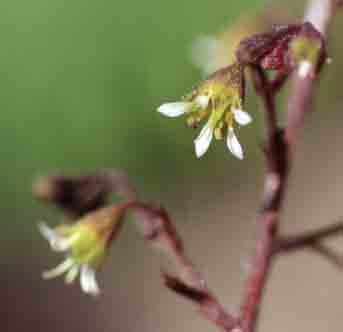The Plant w/Flowers

The Flowers

Description
"Heuchera, commonly called coral bells or alumroot, is a genus consisting of about 55 species of evergreen to semi-evergreen herbaceous perennials which are all native to North America. Plants grow in a variety of different habitats including woodland areas, Appalachian seeps, prairies, rocky cliffs and alpine slopes. Plants range in size from dwarf alpine plants with flower spikes rising to only 5” tall to much larger woodland plants with flower spikes towering to 36” tall. Species plants are primarily native to the West, particularly in the Rocky Mountains, with a few species extending into northern Mexico. However, some important species are native to woodland areas in the East and Southeast.
The first significant hybrid heucheras were introduced into commerce around 1980, with the volume of new introductions increasing to almost avalanche proportions in recent years. Hybrids have now supplanted species plants in the marketplace. Species plants most frequently used in producing the hybrids of today are H. sanguinea, H. americana, H. micrantha, H. villosa and H. cylindrica. Leaves of hybrid plants are available in an expanded variety of colors including various shades of green, blue-green, violet, purple, maroon, bronze, silver-black, orange-yellow, yellow, or red, but often with a streaked, mottled or marbled variegation which sometimes includes bold contrasting veins. Flowers of hybrid plants are also available in a variety of different colors including various shades of white, pink, coral or red.
Genus name honors Johann Heinrich von Heucher (1677-1747), physician, botanist and medicinal plant expert at Wittenberg University, Germany.
Common name of coral bells is in reference to the red bell-shaped flowers produced by Heuchera sanguina. Common name of alum root is in reference to the medicinal use of some species plants as an astringent to stop bleeding.
‘Obsidian’ is a clump-forming, coral bells hybrid that is noted for its dark purple to almost black leaves that remain dark throughout the growing season. The rounded, lobed, long-petioled leaves form a compact basal mound to 8-10” tall and 16” wide. Small, creamy white flowers borne in open, airy panicles appear in late spring to early summer on slender, wiry stems rising well above the foliage mound, typically to 20-24” tall. Obsidian is a dark colored to black volcanic glass that is often used as a gemstone. U. S. Patent PP14,836 issued May 24, 2004." (missouribotanicalgarden.org)
Internet Resources